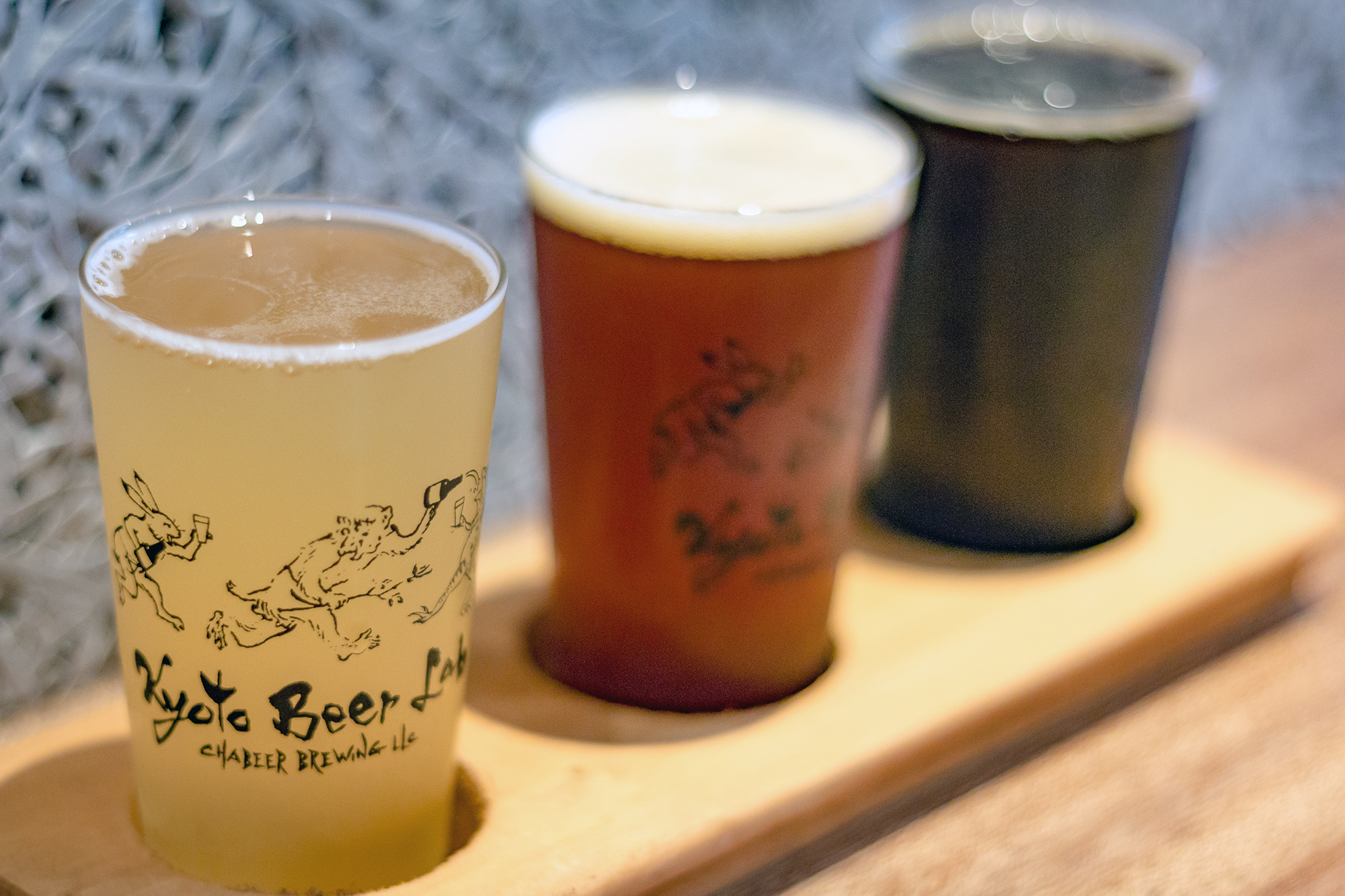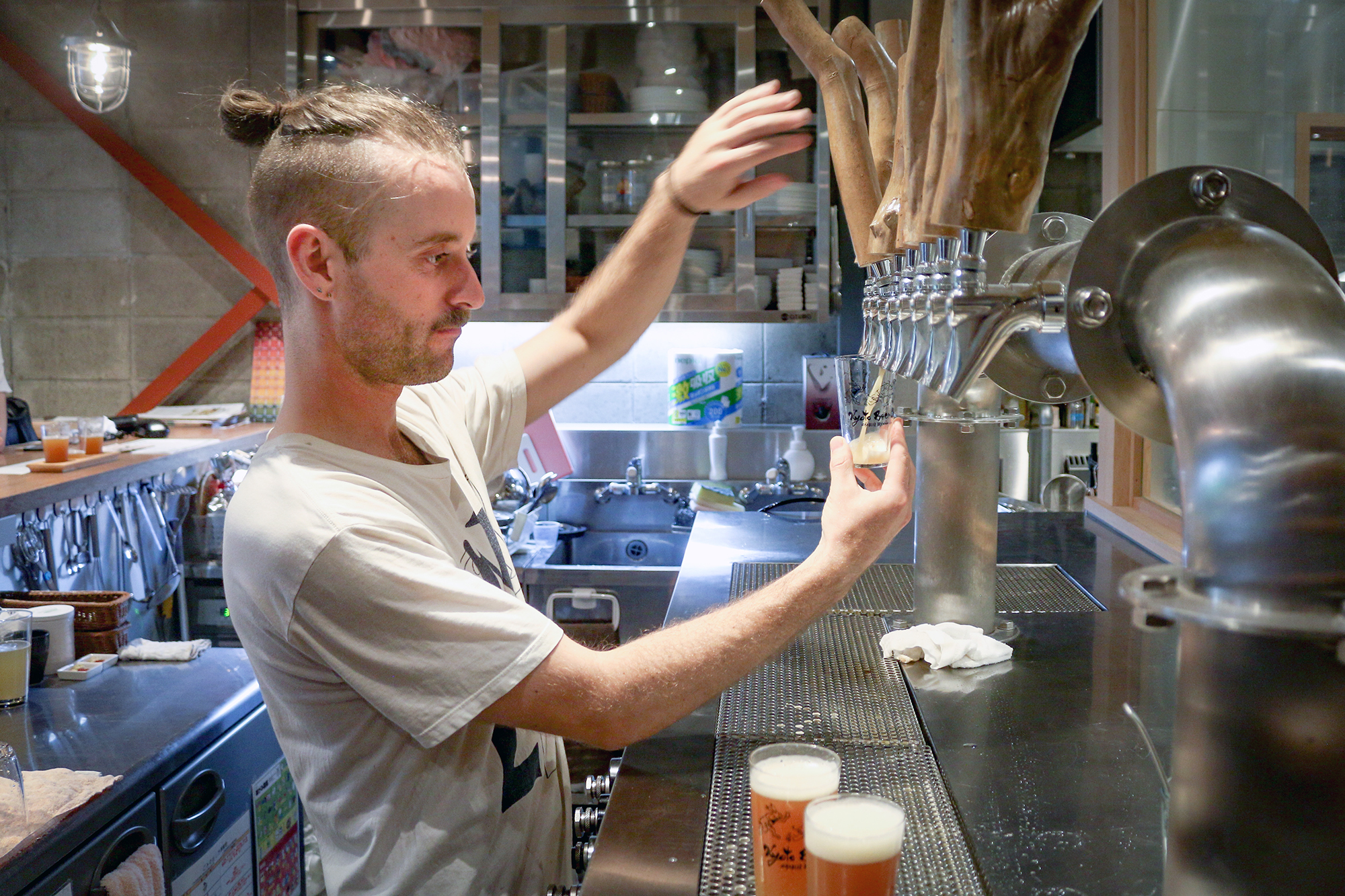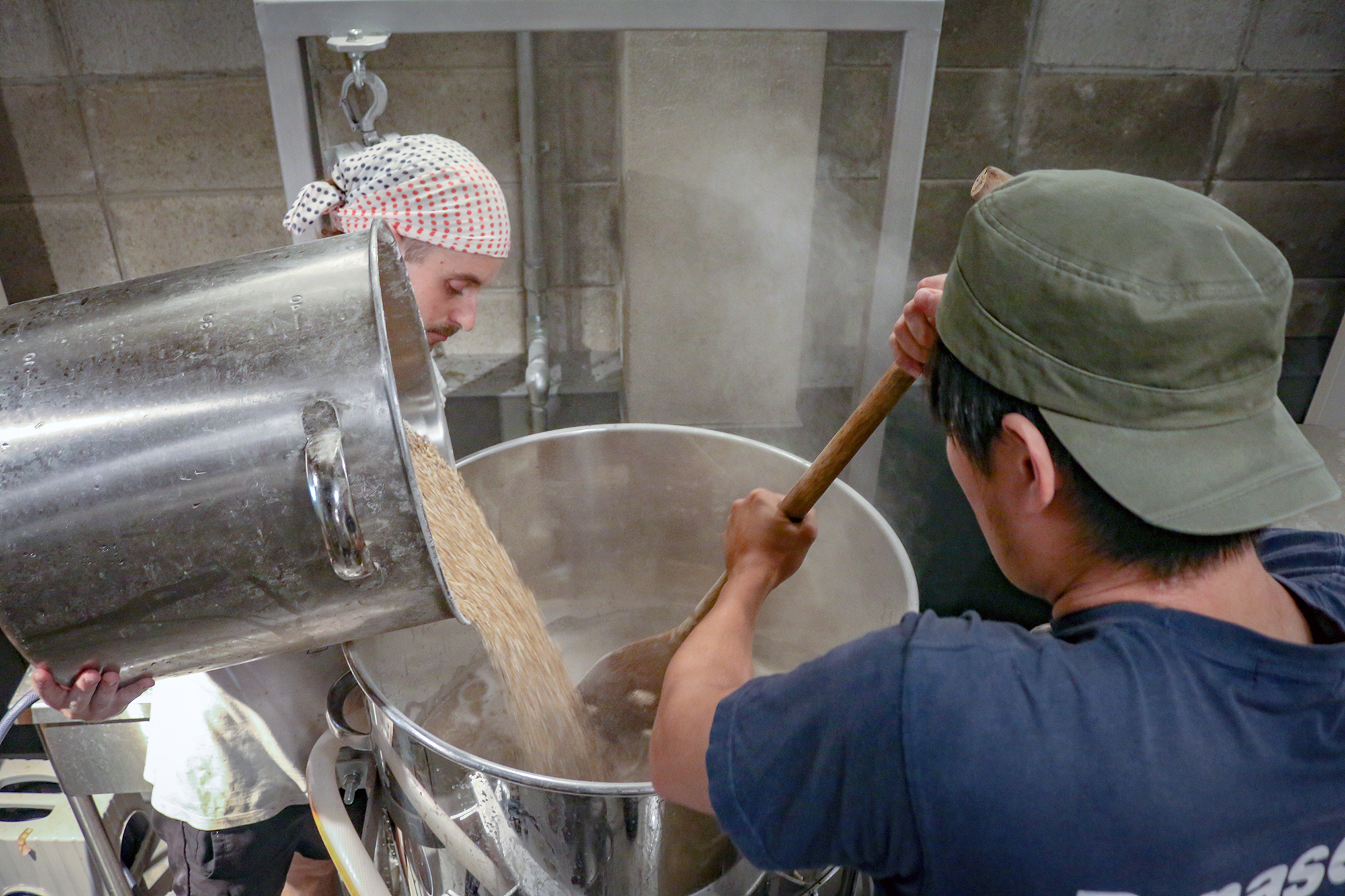Tom Ainsworth is always smiling. It’s like he has constant mischief on his mind. Or that he was born with a surplus of friendliness. To many, it seems Australians have an abundance of that human quality. Or maybe he loves his job as brewer and part-owner at Kyoto Beer Lab that much. Either way, it’s infectious. It puts you in the mood for enjoying beer.
His small brewpub, which opened this past spring, faces the shallow, meandering stream that runs south from Kiyamachi. The quiet street is richly green with trees, shrubs and the careful, small-scale landscaping that marks much of Kyoto. The great Kamogawa runs parallel to the street just a couple of blocks away. Heavy gray clouds hang low, harbingers of the rainy season. The river and stream both will be swelling with water before long.
Looking out from the simple, wooden counter of the place, it’s hard to believe this oasis is less than five minutes on foot from Shichijo Station, and a mere fifteen minutes from the behemoth that is Kyoto Station. It’s seems like the ideal place for a downtown brewpub. Of course, ideally speaking, it should also have great beer.
Brewpubs of this size are usually hit or miss. Consistency is a constant challenge; avoiding off-flavors, an abiding concern. They also offer great flexibility. Brewers can have a field day on such a system, experimenting on a daily basis (if they are selling all the beer, which is certainly possible), and getting direct customer feedback nightly. Ainsworth is definitely making the most of these advantages–no doubt, smiling while doing so. He typically brews between 100 and 200 liters at a time. He has four 200L tanks and three 400L tanks (for double batches). One wall of the brewpub near the entrance is actually a blackboard with eight offerings, a couple of them guest taps depending on his stock.
Ainsworth begins pouring the full line-up, even bringing a few from the back which he hasn’t tapped for the public yet. All of them are surprisingly good–which begs the question, why would one suspect they might not be? Besides the challenges of size noted above, he also hasn’t been open but for a few months. Small brewpubs are opening in Japan at a surprising (some might say “worrisome”) pace, and many consumers will tell you that these establishments seem to be getting ahead of themselves, chasing the dream or the promise of profit before mastering the art and the process of quality control. Even Ainsworth laments that he was rushed at his opening and that his New England-style IPAs came out far cloudier than he wanted. A couple of months later, though, he seems to have dialed in the recipes–or at least found more time to brew at a more comfortable and appropriate pace.
Roughly half of the lineup is in the pale ale and IPA range. One selection is a delicious gose. Another is an interesting (and highly drinkable) tea-infused beer. The latter, part of the “Cha Beer” line, is perhaps the one constant of Kyoto Beer Lab’s menu and representative of the company’s roots. Before Kyoto Beer Lab came into existence, Ainsworth’s partner Hidekazu Muragishi obtained a brewing license and quietly brewed tea-infused beers for a couple of years. The beers were little-known even in Kyoto and had limited commercial success before the two decided to join forces.
The pair met around September of 2016. Ainsworth had been teaching English in Shiga for a couple of years, but had some brewing in his background. For Muragishi, tea-infused beer seemed like a natural fit for Kyoto and the region, where tea is famous, but he sought a partner. He seems to have found a willing and talented one in Ainsworth.
“I went back home for summer of 2016-17 (New Year’s in the southern hemisphere) and practiced brewing his tea beers in my family home for about four months. Then I came back to Japan around the start of April. We spent the year setting up Kyoto Beer Lab, and it’s all history from there!”
They helped pour the concrete themselves. Ainsworth also used to work on building sites and claims to be good with carpentry–the build-out of the bar is certainly attractive. He also assembled the machinery. They literally set up the shop. History, though, requires a little more retracing before we get to the opening.
Ainsworth was a homebrewer who got the opportunity to begin working on professional machinery through friends at The Grifter Brewing Company in the suburbs of Sydney. He had also studied Japanese before taking on the teaching position in Japan for a little adventure in life: a year-and-a-half at his university, a three-week course in Okinawa, and then a half-year study abroad at Momoyama Gakuin in Osaka. He’s fluent in Japanese now and, despite his time in Kyoto, still exchanges banter in the Shiga dialect.
In Japan, he has not gone it totally alone on the brewing side, either. He is quick to give thanks to the help and knowledge he’s received from Itsuo Yamaguchi at Iwami Bakushu, Chris Hainge at Kyoto Brewing Company, Yoshihiro Ohtani at Nagahama, and Gareth Burns at Be Easy Brewing Co. He notes he can still fall back on his friends at Grifter when he needs.
Doing business in Kyoto, though, is not easy. Perhaps brewing is the easier task. The ancient city’s complex cultural and business protocol is legendary. Finding an appropriate place (and a landlord willing to let them brew) of course took time. Ainsworth jokes, “I’m really average at paperwork and Japan is not a forgiving place for that kind of shortcoming.” Luckily, Kyoto Beer Lab has Muragishi, who had already been operating in the city, and taproom manager Hiroki Yokoyama to help navigate. One wonders, too, how much Ainsworth’s smile and boyish charm helped loosen up otherwise rigid attitudes.
Ainsworth is positive on his prospects in the city, noting, “Kyoto, I think, is really supportive of craft beer. It’s always been lauded for its very high levels of hand-crafted goods. A personal touch is appreciated in this city more than anywhere else I’ve been in Japan. And that’s really what we offer here; there’s a handmade feel to both the shop and the brewing. But that also comes with a high expectation of quality, which puts a lot of pressure on the brewer… me!”
He may laugh off the pressure but competition is fierce in Kyoto, for both locals and the growing hoards of tourists. Even the craft beer industry in Kyoto has seen a dramatic increase in bars and breweries, as we noted last issue. Kyoto Beer Lab is at least fortunate that Muragishi’s tea beers had already created a small following and customers were specifically coming for that reason. But while they’re at the bar, Ainsworth can introduce them to his creations. Ainsworth remarks, “I don’t see a need to permanently have KBL Pale Ale on tap #3, for example, but beers that customers like will come back again and again through the years, for sure.”
———
When I revisit the next day, Ainsworth is starting a collaboration brew with Ohtani from Nagahama Brewery. Ohtani’s wife is in the front taproom rocking their infant child to sleep. The brewery space in the back is cramped with the three of us. Ainsworth claims to be exhausted from retrieving all the kegs from Osaka’s Craft Beer Live festival, which has just ended, but he’s still beaming with a smile. It’s another brew day.
On the topic of collaborations, Ainsworth starts, “I’ve been talking to Ohtani for a while about doing a collaboration with this interesting new hop, Calypso. I really like the idea of collaboration beers. Beer brewing is like cooking—everyone has their own habits, their own tricks. There’s no way you can learn all of them yourself, so it’s actually heaps of fun writing recipes together, putting in ideas, challenging each other’s perception of what it is that makes the beers worth selling. Learn, make a fresh batch and go deep into the beer–that’s what it’s all about.”
Ainsworth’s milling machine is an interesting contraption that he built himself by adapting a drill to power the grinder. “Don’t take a picture of this,” he laughs. “It’s not our proudest piece of machinery.” But it works. The rest of the machinery in the brewery has a similar hand-fashioned appearance. Even the music pumping from a speaker on a small desk in the corner of the brewery has the feel of something having been mixed together on the go by some anonymous DJ.
Ainsworth is himself a musician, a “pretty decent drummer” by his own estimation, who is “madly into all sorts of music”. He’s been playing drums since age eleven and keeps himself busy playing gigs at night with four different bands in Kyoto and Osaka. The previous evening he had band practice and will be heading for another session after this brew day is done.
“I mostly play punk, death metal, stuff like that. But actually deep down I want to form a disco band with trumpets, sax, the like. I’m also practicing Mongolian throat singing.”
His description of his musical interests almost sounds like a metaphor for his brewing activity. He’s going to pursue whatever attracts him at any given moment, regardless of whether it relates in any way to what he previously brewed. “Eclectic brewing style” is probably how most would characterize this approach. It seems like a normal fit for Ainsworth and for a brewery like this in a cosmopolitan city. “Beer Lab” suggests experimentation, discovery, surprise. You’ll find that here. Come add your variable to the mix.
This article was published in Japan Beer Times # () and is among the limited content available online. Order your copy through our online shop or download the digital version from the iTunes store to access the full contents of this issue.






